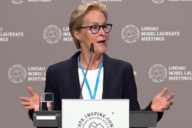You have /5 articles left.
Sign up for a free account or log in.
The number of international students at U.S. universities increased 7.2 percent in 2012-13 to an all-time high of 819,644, according to the latest “Open Doors” survey of international enrollments and American study abroad participation, conducted annually by the Institute of International Education. The number of Americans studying abroad grew to 283,332 in 2011-12, representing a 3.4 percent increase over the previous year.
The overall increase in international student enrollments was fueled by continuing growth in the number of students from the first and fourth-largest sending countries, respectively, China (up 21.4 percent) and Saudi Arabia (up 30.5 percent) – increases that more than made up for slight declines from the second and third-largest sending countries, India (down 3.5 percent) and South Korea (down 2.3 percent).
Click here to view an interactive graphic on the 2012-13 International Enrollments in the U.S.
American study abroad participation increased both in some of the traditionally popular destinations, such as the United Kingdom, the number one destination country (up 4.5 percent), as well as in less traditional destinations such as Latin America and the Caribbean (up 11.7 percent regionwide). Study in China, the fifth-most popular destination, increased 2 percent.
The number of American students studying abroad has more than tripled over the past 20 years from a base of about 71,000 in 1991-2. Even so, just 9.4 percent of all American undergraduates study abroad at some point during their degree program and nearly 60 percent of students who do go abroad go for just for a summer or on other short-term programs of eight weeks or less.
Delving into the Data: International Students
Rajika Bhandari, IIE’s deputy vice president for research and evaluation, noted that the growth in international students is particularly striking in that it is of an across-the-board nature: the top 10 states that host international students all saw increases, as did all 20 of the top institutions hosting international students (see interactive map).
Top 25 Countries of Origin for International Students in the U.S. in 2012-13
|
Country |
Number of Students |
Percent Change from 2011-12 |
|
1. China |
235,597 |
21.4 |
|
2. India |
96,754 |
-3.5 |
|
3. South Korea |
70,627 |
-2.3 |
|
4. Saudi Arabia |
44,566 |
30.5 |
|
5. Canada |
27,357 |
2 |
|
6. Taiwan |
21,867 |
-5.9 |
|
7. Japan |
19,568 |
-2 |
|
8. Vietnam |
16,098 |
3.4 |
|
9. Mexico |
14,199 |
2.2 |
|
10. Turkey |
11,278 |
-5.8 |
|
11. Brazil |
10,868 |
20.4 |
|
12. Germany |
9,819 |
5 |
|
13. United Kingdom |
9,467 |
3.1 |
|
14. Nepal |
8,920 |
-7.3 |
|
15. Iran |
8,744 |
25.2 |
|
16. France |
8,297 |
0.8 |
|
17. Hong Kong |
8,026 |
-0.1 |
|
18. Indonesia |
7,670 |
7.6 |
|
19. Nigeria |
7,316 |
4.1 |
|
20. Thailand |
7,314 |
-4.1 |
|
21. Malaysia |
6,791 |
0.7 |
|
22. Colombia |
6,543 |
3.9 |
|
23. Venezuela |
6,158 |
-2 |
|
24. Kuwait |
5,115 |
37.4 |
|
25. Spain |
5,033 |
2.2 |
Source: Institute of International Education
The numbers of Chinese and Saudi Arabian students in the U.S. have both been increasing by double-digit percentages for years now, with much of the growth happening at the undergraduate level. The number of Chinese undergraduates increased by 25.9 percent in 2012-13, 30.8 percent the year before, and 43 percent the year before that. The total number of students from China at all degree levels is now 235,597, and they make up 28.7 percent of all international students in the U.S. “This is the largest concentration of students from any one place of origin that the U.S. has ever seen,” Bhandari said.
Ten Years of Chinese and Saudi Arabian Students in the U.S.
|
Year |
Number of Students from China |
Percent Change from Previous Year |
Number of Students from Saudi Arabia |
Percent Change from Previous Year |
|
2012-13 |
235,597 |
21.4 |
44,566 |
30.5 |
|
2011-12 |
194,029 |
23.1 |
34,139 |
50.4 |
|
2010-11 |
157,558 |
23.5 |
22,704 |
43.6 |
|
2009-10 |
127,628 |
29.9 |
15,810 |
24.9 |
|
2008-9 |
98,235 |
21.1 |
12,661 |
28.2 |
|
2007-8 |
81,127 |
19.8 |
9,873 |
25.2 |
|
2006-7 |
67,723 |
8.2 |
7,886 |
128.7 |
|
2005-6 |
62,582 |
0.1 |
3,448 |
13.6 |
|
2004-5 |
62,523 |
1.2 |
3,035 |
-13.8 |
|
2003-4 |
61,765 |
-4.6 |
3,521 |
-15.7 |
Source: Institute of International Education
The growth in students from Saudi Arabia is largely attributable to a generous government scholarship program that started in 2005. Government scholarship programs likewise fueled the healthy gains in the number of students from Brazil (up 20.4 percent) and Kuwait (up 37.4 percent). The growth of the government scholarship programs, combined with the rapid rate of increase in Chinese undergraduate students in recent years, are all factors in explaining why international undergraduates outnumber foreign graduate students in the U.S. for the second year in a row after more than a decade in which the opposite was the case.
Another notable increase involves the number of students from Iran, which increased 25.2 percent, albeit from a relatively small base. Students from Iran, like China, are primarily self-funded as opposed to on sponsored programs. IIE found that personal or family resources were the primary source of funding for 63.6 percent of all international students in the U.S. Based on its analysis of Open Doors data, NAFSA: Association of International Educators estimates that in 2012-13 international students and their families contributed $24 billion to the American economy in tuition payments and living expenditures.
Notably, the number of students from the second-largest sending country, India, declined by 3.5 percent in 2012-13 after an identical drop the year before. And a “snapshot survey” of fall 2013 enrollment – a separate, far less comprehensive survey that IIE also publishes in conjunction with seven other higher education associations -- found that Indian enrollments continued to decline this fall, by 10 percent.
This presents a contrast to yet a third dataset, this one from the Council of Graduate Schools, which found a 40 percent surge in new graduate enrollments from India this fall. Bhandari noted that the Open Doors and snapshot survey data include both undergraduate and graduate students – not just graduate enrollment as in the case of the CGS data – and said that undergraduates are more likely to be sensitive to the effects of the declining value of the rupee than graduate students, many of whom are financed by their institution.
Jeff Allum, director of research and policy analysis at CGS, said it was difficult to reconcile the large surge in students from India that CGS saw at the graduate level with the overall declines recorded in the snapshot survey (on which CGS collaborated). "My only explanation is we have a slightly different sample pool and a different questionnaire," he said.
"What I can say is I’m very confident in the numbers we provided," Allum said. Over three separate surveys, CGS found growth in interest from Indian students at every step in the graduate application process. Total applications to U.S. graduate schools from Indian students increased 22 percent this fall, offers of admission increased by 30 percent and, again, new enrollments rose by 40 percent.
The India numbers aside, indications from both Open Doors and the snapshot survey suggest that the general upward trend in international enrollments will continue in the near future. Open Doors found that first-time international enrollments increased 9.8 percent in 2012-13, compared to the overall growth rate of 7.2 percent. And the snapshot survey – which, while far less comprehensive and representing 380 universities rather than the approximately 3,000 included in Open Doors — nonetheless gives a preliminary peak as to what the picture looks like this academic year. And the picture generally looks good: 72 percent of colleges responding said they saw an increase in international students this fall. The average rate of increase was 13 percent, with more growth occurring at the undergraduate level. Universities reported growth from China (up 7 percent), Iraq (up 55 percent), Saudi Arabia (up 25 percent), Brazil (up 17 percent) and Vietnam (up 14 percent).
Many of the respondents to the snapshot survey said that they have added additional services and English as a Second Language courses to support and integrate the growing numbers of Chinese students. Even so, many universities said they continue to struggle to provide adequate English language training to Chinese students and to diversify their international student body.
Americans Studying Abroad
The 3.4 percent growth in American study abroad participation in 2011-12 represented a stronger rate of growth than in the previous year, when participation rose by just 1.3 percent. Many of the traditional European destinations recorded increases – with the exceptions of Italy, Greece and Austria -- while there were big percentage gains in Latin American countries in particular: Costa Rica (up 9.3 percent), Argentina (up 3.8 percent), Brazil (up 16.5 percent), Ecuador (up 15 percent), and Peru (up 9.5 percent). The number of students going to Mexico continues to slide due to safety concerns, while the numbers to Japan rebounded after a steep fall-off last year following the tsunami and Fukushima nuclear disaster.
Leading Destinations for Americans Studying Abroad in 2011-12
|
Country |
Number of Students |
Percent Change from 2010-11 |
|
1. United Kingdom |
34,660 |
4.5 |
|
2. Italy |
29,645 |
-2.4 |
|
3. Spain |
26,480 |
2 |
|
4. France |
17,168 |
0.9 |
|
5. China |
14,887 |
2 |
|
6. Germany |
9,370 |
3.9 |
|
7. Australia |
9,324 |
-4.2 |
|
8. Costa Rica |
7,900 |
9.3 |
|
9. Ireland |
7,640 |
9 |
|
10. Japan |
5,283 |
27.8 |
|
11. Argentina |
4,763 |
3.8 |
|
12. India |
4,593 |
5.7 |
|
13. South Africa |
4,540 |
4.7 |
|
14. Brazil |
4,060 |
16.5 |
|
15. Mexico |
3,815 |
-8.4 |
|
16. Ecuador |
3,572 |
15 |
|
17. Czech Republic |
3,477 |
5.7 |
|
18. Israel |
3,189 |
-7.3 |
|
19. Chile |
3,064 |
-6.6 |
|
20.New Zealand |
2,969 |
2.4 |
|
21. Denmark |
2,876 |
16.1 |
|
22. Greece |
2,701 |
-21.2 |
|
23. South Korea |
2,695 |
8.4 |
|
24. Peru |
2,680 |
9.5 |
|
25. Austria |
2,657 |
-2.9 |
Source: Institute of International Education
The profile of Americans who study abroad – which skews white and female – remained largely unchanged from the year prior, but there were some striking changes in some fields of study. The number of engineering students who study abroad increased by 16.3 percent, for example, and the number for physical and life sciences grew 12.8 percent. These are marked increases in fields that historically send fewer students abroad than the social science and humanities disciplines.
American Study Abroad Participation by Field of Study, 2011-12
|
Field of Study |
Number of Students |
Percent of Total Study Abroad Enrollment |
Percent Change from 2010-11 |
|
Social Sciences |
63,427 |
22.4 |
1.1 |
|
Business |
58,091 |
20.5 |
3.4 |
|
Humanities |
30,667 |
10.8 |
-1 |
|
Physical or Life Sciences |
24,413 |
8.6 |
12.8 |
|
Fine or Applied Arts |
22,138 |
7.8 |
-1.5 |
|
Health Sciences |
16,138 |
5.7 |
11.1 |
|
Foreign Languages |
14,890 |
5.3 |
-3 |
|
Education |
11,539 |
4.1 |
0.3 |
|
Engineering |
11,149 |
3.9 |
16.3 |
|
Math or Computer Science |
4,861 |
1.7 |
-1.4 |
|
Agriculture |
3,360 |
1.2 |
-5.7 |
|
Other Fields of Study |
14,294 |
5 |
8.7 |
|
Undeclared |
8,365 |
3 |
13.1 |
Source: Institute of International Education
Again, the majority of students going abroad participate in short-term programs. Just 35.4 percent of students studied abroad for a semester or two quarters and another 3.3 percent went overseas for a whole academic or calendar year.
Insert pie chart of study abroad by duration here
New York University led the way in terms of total study abroad participation and also topped the list in regards to the number of students it sends on long-term and mid-length programs. The universities and colleges with the highest undergraduate participation rates in study abroad, by institutional type, were as follows: for doctoral universities, Boston College, American University, and the Universities of San Diego, Denver and Notre Dame; for master’s-level universities, Arcadia, Elon, Hamline and Lee Universities and the University of Dallas; and for baccalaureate colleges, Soka University of America, Webber International University, Centre College, Taylor University and Goucher College.




